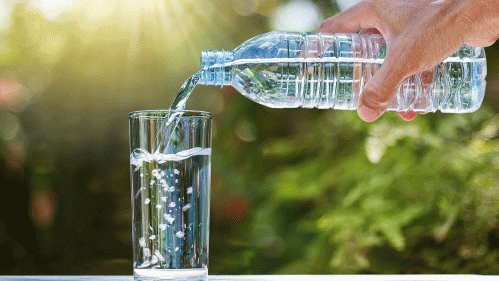What’s in Your Bottled Water? Study Suggests There May Be Hundreds of Thousands of Tiny Plastic Bits

A Rutgers Health researcher collaborates to develop a microscopic technique that zeroes in on the poorly explored world of nanoplastics, which can pass into one’s blood, cells and brain
A breakthrough microscopic technique that can detect minute particles of plastic in bottled water that can pass into human blood, cells and the placenta with unknown health effects has been developed by a team of researchers from Rutgers Health and Columbia universities.
In a study published in the journal Proceedings of the National Academy of Sciences, Rutgers and Columbia researchers counted and identified particles in bottled water, finding that on average one liter of water contained some 240,000 detectable plastic fragments – 10 to 100 times greater than previous estimates based mainly on larger sizes of plastic.
“Recently we, as scientists, have been able to visualize and identify large plastic particles in human tissues, including the lung and placenta,” said study coauthor Phoebe Stapleton, an associate professor in the department of pharmacology and toxicology at the Rutgers Ernest Mario School of Pharmacy and resident scientist in the Rutgers Environmental and Occupational Health Sciences Institute. “This methodology opens the door to evaluate smaller particles with greater toxicological potential and concern.”
Microplastics are showing up nearly everywhere on Earth —from polar ice to soil, drinking water and food — with little known about how they affect the ecosystem. Formed when plastics break down into progressively smaller bits, these particles are being consumed by humans and other creatures.
The far smaller nanoplastics – particles below 1 micrometer and measured in billionths of a meter – are so tiny that they can pass through environmental filters and biological barriers, including the lungs and intestines and from there can travel to organs, including the heart, brain, and placenta. They can invade individual cells and cross through the placenta to the bodies of developing fetus.
For the new study, researchers used a technique called stimulated Raman scattering microscopy, which was co-invented by Wei Min, a Columbia biophysicist and coauthor of the study. The technique involves probing samples with two simultaneous lasers that are tuned to make specific molecules resonate. Targeting seven common plastics, the researchers created a data-driven algorithm to interpret the results. “This technique is revolutionary in the field,” Stapleton said. “It not only allows us to detect nanoplastics, but also to identify the polymer type.”
The researchers tested three popular brands of bottled water sold in the United States, analyzing plastic particles down to 100 nanometers in size. They spotted 110,000 to 370,000 particles in each liter, 90 percent of which were nanoplastics; the rest were microplastics. They also determined which of the seven specific plastics they were and charted their shapes – qualities that could be valuable in biomedical research.
One common plastic is polyethylene terephthalate (PET), used in water bottles and condiment packaging. The other is polyamide, a type of nylon. The seven types of plastic the researchers searched for accounted for about 10 percent of all the nanoparticles they found in samples. The researchers said they have no idea what the rest are. If they are all nanoplastics, that means they could number in the tens of millions of particles per liter. But they could be almost anything, “indicating the complicated particle composition inside the seemingly simple water sample,” the authors write.
The researchers are now reaching beyond bottled water. Stapleton and her team are continuing to evaluate micro and nanoplastics within a maternal-fetal model, specifically to understand how exposure to during pregnancy may affect fetal health and development. Her group has previously identified and visualized transfer and deposition of nanosized polystyrene particles into fetal tissues (i.e., placenta, heart, brain, liver, lung, and kidney) within 24h after maternal gastric or pulmonary exposure, respectively. She and her collaborators are looking forward to continue to use stimulated Raman scattering microscopy to identify micro and nanoplastic particles in a wide range of human and laboratory biological samples to examine the local cellular interactions and system toxicities.
The study was coauthored by Phoebe Stapleton of Rutgers Health at Rutgers University; Xin Gao and Xiaoqi Lang of the Columbia chemistry department; Huipeng Deng and Teodora Maria Bratu of Lamont-Doherty; and Qixuan Chen of Columbia’s Mailman School of Public Health.

